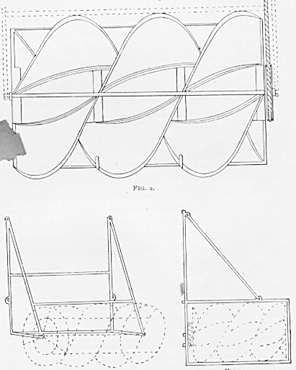THE SCREW PROPELLER PREVIOUS TO 1802
Water wheels for mills, driven by the action of a current of water against their vanes or blades, placed obliquely to the direction of the current, have been used in China for centuries; and in Spain, from the time of its conquest by the Moors.
Prior to the Revolution, they were in use in this country for mills; and were called Chinese sculls, or tub wheels. In principle, this wheel is identical with the windmill; and, when attached to a vessel, and driven by power applied to its shaft, it is the screw propeller.
Colonel Stevens, in his letter to Dr. Hare, given below, considered himself its inventor for the propulsion of vessels; but he was mistaken. It was proposed by the mathematician David Bernouli, in 1752; and it is described by David Bushnell, in a letter to Thomas Jefferson, dated 1787, giving an account of his sub-marine boat, to which this screw propeller, worked by hand, was applied; and of his attempt, with this boat, to blow up a 50-gun British ship in the harbor of New York.
The same idea, of the propulsion of vessels by means of spiral wheels, was afterwards suggested by Franklin, Watt, Paucton and others.
Previous to the year 1802, the screw propeller was twice distinctly patented in England; and the invention was described, in each patent, by a specification and drawing. The patent to William Lyttleton was granted in 1794; and his screw propeller is shown in the drawing annexed.

| This screw propeller, was a long spiral wheel, revolved by an endless rope on a pulley worked by manual labor. It was tried on a vessel at the Greenwich dock, London; and a speed of two miles an hour was said to have been attained. The second patent was granted to Edward Shorter in 1800. Shorter had two plans, one, Fig. 5, a form of duck-foot paddles, with an alternate movement, often proposed and tried, before and since; the other, Fig. 6, a two bladed screw propeller, attached to an inclined shaft carried by a universal joint to the deck of the vessel. Both plans are shown in the annexed drawings. By one of Shorter's plans, but by which one is uncertain, the transport " Doncaster " was said to have been propelled at a speed of a mile and a half an hour, by eight men working at a capstan. |
| Lyttleton's Screw Propeller and devices for attaching it to the ship's sides, bow or stern.*
*Traced from his Patent Specifications No. 2000. A. D. 1794, July 15.
|
 Back to Introduction
Back to Introduction

 Back to Introduction
Back to Introduction